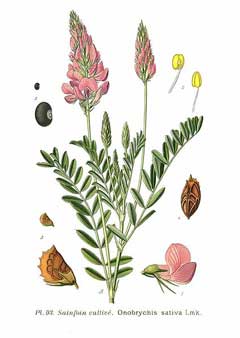 |
|
http://commons.wikimedia.org/wiki/File:93_Onobrychis_sativa_Lmk.jpg |
 |
| http://commons.wikimedia.org/wiki/User:Lycaon |
Translate this page:
Summary
Physical Characteristics

 Onobrychis viciifolia is a PERENNIAL growing to 1 m (3ft 3in).
Onobrychis viciifolia is a PERENNIAL growing to 1 m (3ft 3in).
See above for USDA hardiness. It is hardy to UK zone 6. It is in flower from June to August. The species is hermaphrodite (has both male and female organs) and is pollinated by Bees. The plant is not self-fertile.
It can fix Nitrogen.
It is noted for attracting wildlife.
Suitable for: light (sandy) and medium (loamy) soils, prefers well-drained soil and can grow in nutritionally poor soil. Suitable pH: neutral and basic (mildly alkaline) soils and can grow in very alkaline soils.
It cannot grow in the shade. It prefers moist soil.
UK Hardiness Map
US Hardiness Map
Synonyms
O. sativa.
Plant Habitats
Meadow;
Edible Uses
Edible Parts: Leaves
Edible Uses:
One report says that the plant is edible[20], but does not say what part of the plant is used.
References More on Edible Uses
Medicinal Uses
Plants For A Future can not take any responsibility for any adverse effects from the use of plants. Always seek advice from a professional before using a plant medicinally.
None known
References More on Medicinal Uses
The Bookshop: Edible Plant Books
Our Latest books on Perennial Plants For Food Forests and Permaculture Gardens in paperback or digital formats.

Edible Tropical Plants
Food Forest Plants for Hotter Conditions: 250+ Plants For Tropical Food Forests & Permaculture Gardens.
More

Edible Temperate Plants
Plants for Your Food Forest: 500 Plants for Temperate Food Forests & Permaculture Gardens.
More

More Books
PFAF have eight books available in paperback and digital formats. Browse the shop for more information.
Shop Now
Other Uses
Soil conditioner Soil stabilization
A good soil conditioner for poor light soils[115]. The plants can be grown on the land for a number of years, the deep tap roots breaking up the sub-soil and bringing up minerals from below. Plants can be cut during the growing season but care must be taken not to cut too low because the tap root tends to rise above ground level and the plant can be killed if this is cut off[115]. The plant has an extensive root system and is useful for stabilizing soils[160, 200]. Nitrogen Fixer.
Special Uses
Attracts Wildlife Food Forest Nitrogen Fixer
References More on Other Uses
Cultivation details
Prefers a well-drained neutral to alkaline sandy loam in full sun[1, 200]. Succeeds in poor soils[115] and in shallow soils over chalk[200]. Dislikes shade. Does not succeed in wet soils[115]. A good border plant for the vegetable garden[18, 20], the deep tap root helps to break up the sub-soil[115]. Plants are resistant to alfalfa stem nematodes[160] and are immune to bacterial wilt disease and attacks by the alfalfa stem weevil[160]. A good bee plant[200]. This species has a symbiotic relationship with certain soil bacteria, these bacteria form nodules on the roots and fix atmospheric nitrogen. Some of this nitrogen is utilized by the growing plant but some can also be used by other plants growing nearby[200].
References Carbon Farming Information and Carbon Sequestration Information
Temperature Converter
Type a value in the Celsius field to convert the value to Fahrenheit:
Fahrenheit:
The PFAF Bookshop
Plants For A Future have a number of books available in paperback and digital form. Book titles include Edible Plants, Edible Perennials, Edible Trees,Edible Shrubs, Woodland Gardening, and Temperate Food Forest Plants. Our new book is Food Forest Plants For Hotter Conditions (Tropical and Sub-Tropical).
Shop Now
Plant Propagation
Seed - pre-soak for 12 hours in warm water and sow in situ in the spring[1, 200]. Seed can also be sown in situ in the autumn. If seed is in short supply then it might be wiser to sow it in pots in a cold frame in early spring. Prick out the seedlings into individual pots as soon as they are large enough to handle and plant them out into their permanent positions in early summer. Division in the spring just before new growth commences[200]. Large divisions can be planted out direct into their permanent positions. We have found that it is better to pot up the smaller divisions and grow them on in light shade in a cold frame until they are well established before planting them out in late spring or early summer.
Other Names
If available other names are mentioned here
Native Range
EUROPE: Former Yugoslavia, Bulgaria, France
Weed Potential
Right plant wrong place. We are currently updating this section.
Please note that a plant may be invasive in one area but may not in your area so it's worth checking.
Conservation Status
IUCN Red List of Threatened Plants Status :

Growth: S = slow M = medium F = fast. Soil: L = light (sandy) M = medium H = heavy (clay). pH: A = acid N = neutral B = basic (alkaline). Shade: F = full shade S = semi-shade N = no shade. Moisture: D = dry M = Moist We = wet Wa = water.
Now available:
Food Forest Plants for Mediterranean Conditions
350+ Perennial Plants For Mediterranean and Drier Food Forests and Permaculture Gardens.
[Paperback and eBook]
This is the third in Plants For A Future's series of plant guides for food forests tailored to
specific climate zones. Following volumes on temperate and tropical ecosystems, this book focuses
on species suited to Mediterranean conditions—regions with hot, dry summers and cool, wet winters,
often facing the added challenge of climate change.
Read More
Expert comment
Author
Scop.
Botanical References
17200
Links / References
For a list of references used on this page please go here
Readers comment